If you want to understand the flamboyant family of objects that make up our solar system—from puny, sputtering comets to tremendous, ringed planets—you could start by immersing yourself in the technical terms that fill the scientific literature. Oblateness. Grabens. Magnetosphere. Volatiles. By all means, take the plunge if you are so inclined. It is quite rewarding. But if your goal is to develop a more intuitive feel for your place within this colorful community around the sun, you can start the speed course with a single word taken from the world of art: chiaroscuro.
Renaissance artists coined the term to describe a novel aesthetic defined by extreme contrasts between the bright and dim parts of a painting. Chiaroscuro (“light-dark” in Italian) gave the canvas an expansive, three-dimensional feel and a sense of emotional mystery. To the artists who embraced it, including Leonardo, Rembrandt, and Vermeer, this fresh approach also established a sharp break from the hard, flat style of medieval art. To skywatchers, though, chiaroscuro was just an extremely belated recognition of a natural truth that their predecessors had discovered millennia earlier. The workings of the heavens are expressed through the contrasting interplay of light and dark.
The most gorgeous eclipses in the solar system are never visible from Earth.
Although light might seem to be the dominant element in the sky, darkness often contains the most powerful lessons. Darkness defined the most awesome and most feared of astrological events, a total eclipse of the sun, and inspired some of the greatest advances in the history of science. Chinese astrologers began producing written records of eclipses going back to at least 2000 B.C. By the sixth century B.C., the Babylonians had developed a sophisticated calendar that allowed them to predict eclipses with remarkable accuracy.
In modern times, solar eclipses led to the discovery of the element helium and violent eruptions on the sun; in 1919, the shadow of a solar eclipse enabled researchers for the first time to validate Albert Einstein’s general theory of relativity. Even today, chiaroscuro remains a powerful tool of discovery and comprehension. Even today, chiaroscuro remains a powerful tool of discovery and comprehension. All across the solar system, darkness exposes the secret locations that light only obscures: the remarkable places where moons are ripped apart, comets are born, and alien life may be swimming about in an ice-cloaked ocean.
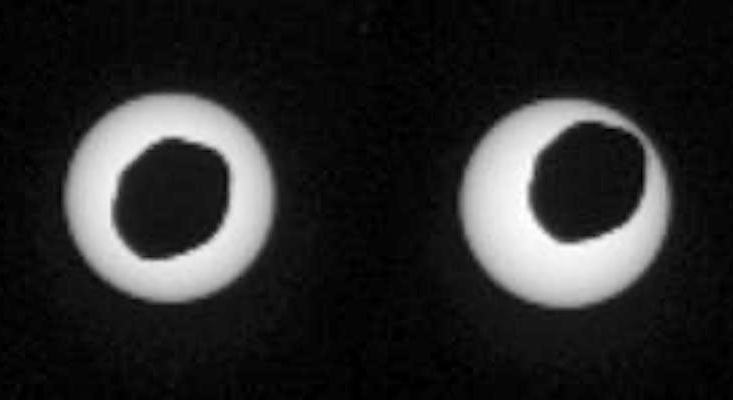
A Blotted Sun on Mars
Solar eclipses are not unique to Earth. They are possible on any world that has a moon aligned with the sun. Mars has two such moons, Phobos and Deimos. Both are tiny—Phobos, the larger, is 14 miles in diameter, scarcely bigger than Manhattan Island—but they also circle extremely close to the planet. As a result, Phobos appears large enough to blot out a large fraction of the sun as seen from the surface of Mars. Phobos also completes an orbit in just 7 hours and 39 minutes, so its dark shadow is constantly sweeping across the Martian landscape.
NASA’s nuclear-powered Opportunity rover observed one of the Phobos eclipses on Aug. 20, 2013. The timing of these events helps planetary scientists to monitor the movements of the Martian moons and to predict their fate. Phobos is steadily spiraling inward toward Mars; the latest calculations indicate that it will be ripped apart by the planet’s gravity in less than 50 million years. Its remains will then be smeared out into a system of rings, like the rings of Saturn but smaller and darker.
The lumpy shape of Phobos is also evident from its irregular silhouette against the sun. Clearly it is not a moon like ours, and for now nobody is sure how it got there. One idea is that Phobos and Deimos are wayward asteroids that were captured by Mars. Another is that they formed from debris blasted off of the planet during a huge, ancient impact. Phobos might even be a kind of celestial Phoenix, born from the remains of an earlier moon that got ripped apart into rings that then reassembled. In 2024, the Japanese Space Agency will launch a mission called MMX (Martian Moons Exploration) to visit Phobos, sample its surface, and fill in the details of this shadow moon.
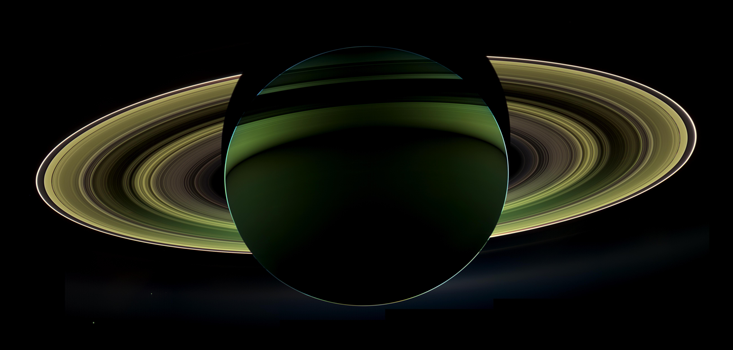
Eclipsed by a Ringed Planet
The most gorgeous eclipses in the solar system are never visible from Earth, but one of them was captured in pointillist detail by the Cassini spacecraft that circled Saturn from 2004 to 2017. On Oct. 17, 2012, during the probe’s 174th orbit, it passed directly behind the planet and plunged into its shadow. All was not truly dark, however. Light from the eclipsed sun can be seen streaming around the edges of Saturn, which allows researchers to study the structure of the planet’s thick, windy hydrogen-helium atmosphere.
The greatest visual drama comes from the planet’s rings, viewed from a unique perspective. Nothing that you see here is illuminated directly by the sun; rather, you are seeing sunshine scattering off the icy chunks that comprise the rings. The colors indicate the structure and composition of those chunks, while the brightness indicates their average size; evidently, they range in scale from dust specks to floating icebergs the size of a small house. The unusual palette is partially due to this unfamiliar type of illumination, and partly due to the way the image was composed: Cassini’s imaging camera took three pictures in infrared, red, and violet light, which were then combined to simulate a color view.
Popping out of the blackness at lower left are two faint, intriguing specks of light. They are Tethys and Enceladus, two of Saturn’s 82 moons. Enceladus is an extraordinary little world, harboring a deep, warm ocean beneath its ice. Astrobiologists now consider it one of the most likely places to search for alien life in the solar system. That effort is being aided by another play of light and shadow. More on that shortly.
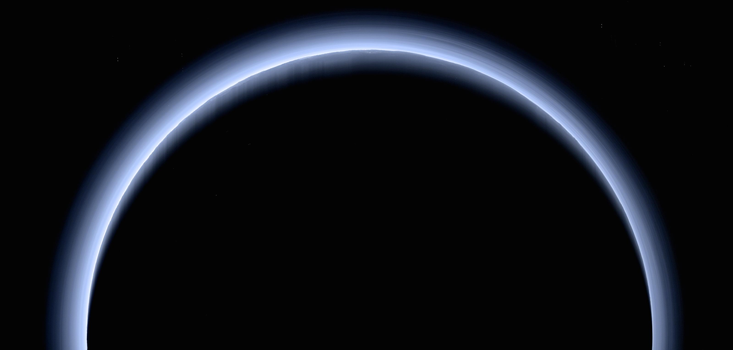
Eclipsed by a Dwarf Planet
Seeing a Saturnian eclipse is a rare thing. Seeing an eclipse of the sun by Pluto is a once-in-a-lifetime event. It happened on July 14, 2015, when NASA’s New Horizons spacecraft flew behind dwarf planet Pluto on its way out of the solar system, and there are no plans for it to happen ever again.
For a long time, Pluto was believed to be an airless, inert world. New Horizons proved otherwise. If Pluto were a bare ball of ice, it would look like a black disk, nearly invisible. The rich blue rim tells a very different story. Despite being smaller than Earth’s moon, and despite temperatures hovering around -390 degrees Fahrenheit, Pluto has a complex atmosphere composed of nitrogen laced with methane and carbon monoxide and filled with an unexpected blue haze. Look closely and you can see that the haze is divided into dozens of layers. Scientists working with the New Horizon data believe the haze is composed of photochemical smog (not unlike L.A. on a bad day), including organic compounds like ethylene and acetylene. The particles are so fine that they scatter mostly blue light, the same reason that our skies are blue. Why they follow such a complicated, layered structure, nobody knows.
Look closer still and you will see streaks of darkness cutting through the haze. These are the shadows of mountains on Pluto—craggy peaks that are composed of deep-frozen water ice and capped with nitrogen glaciers. The shadows resemble the lines of darkness, known as crepuscular rays, that you’ll often see around clouds lit from behind by the sun. Only in this case, the darkness provides our first-ever measure of the topography of Pluto’s frozen terrain.
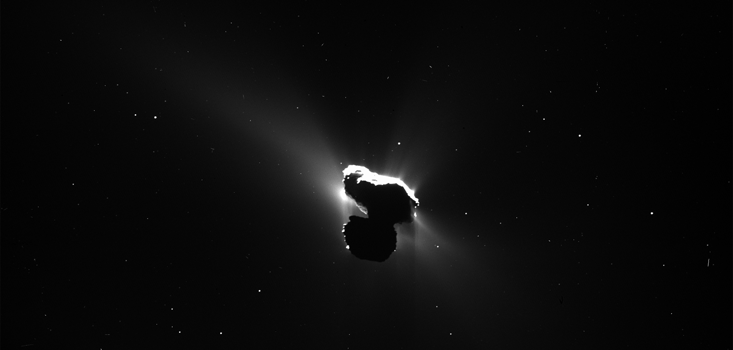
Eclipsed by an Erupting Comet
Anything that passes in front of the sun can create an eclipse. It doesn’t have to be a planet or a moon. A comet will do the trick, too, as seen in this image of the comet known as 67P/Churyumov–Gerasimenko, or just “67P” to its friends. From 2014 to 2016, the European Space Agency’s Rosetta mission studied 67P up close, dropped a small lander on its surface, and obtained by far the best portraits ever taken of the cold, solid nucleus of a comet.
On March 29, 2016, Rosetta captured this view of Comet 67P from a distance of 510 miles. The comet itself is minuscule, a mere 2.5 miles wide across its longest dimension. Strictly speaking, this isn’t a true eclipse; the sun is slightly off to the side rather than directly behind the comet. But in this arrangement, the comet is almost entirely backlit, with its night side facing us, set against a starry backdrop. You can see a trickle of sunshine falling on the top of the comet. What’s really interesting, though, are the fuzzy jets and streamers surrounding the comet, which are especially prominent when illuminated like this from behind.
Comet 67P spent most of its lifetime—billions of years—in the dim gloom of the Kuiper Belt, a region of the outer solar system that extends well beyond Pluto. At some point, it got disturbed and fell inward toward the sun. Then in 1959 it had the misfortune to pass close to Jupiter, which pushed it even closer. Now its frozen gases regularly vaporize under solar heat, releasing clouds of dust that make the jets and streamers visible. What you see here, never seen before, is the first stage of the process that gives comets their tails. The comet itself is about as black as a lump of coal; the vast trail of gas and dust it leaves behind is what catches the sunlight and makes comets appear to glow beautifully in our skies.
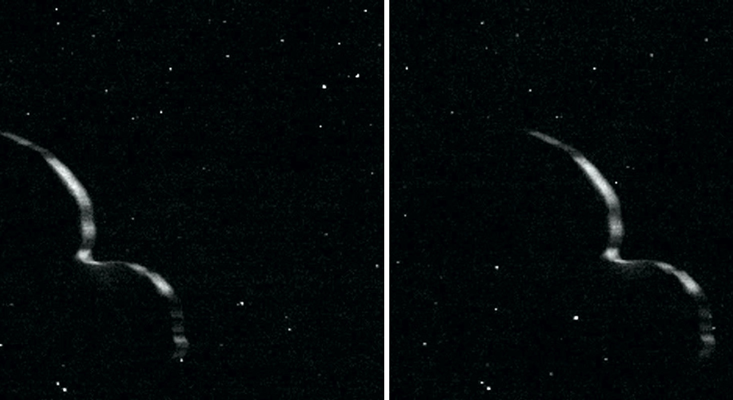
Silhouette in the Kuiper Belt
Sometimes astronomers can’t make sense of what they’re looking at until they can see a shadow. That was the case with the enigmatic object known as Arrokoth. It resides more than 4 billion miles from the sun in the Kuiper Belt (the same region where Comet 67P originated) and was the second destination for New Horizons after its encounter with Pluto and its moons.
Before New Horizons arrived on Dec. 31, 2018, we knew essentially nothing about this object; it had been observed only as a dot in the dark by the Hubble Space Telescope. In the initial spacecraft images, Arrokoth seemed to resemble a 22-mile-tall snowman, with a smaller ball jammed onto a second, larger one. Then a day later, the spacecraft looked back on its target as it was speeding away, and the picture got more complicated.
Arrokoth showed up as two patches of emptiness, where its bulk blocked the light of the background stars, rimmed by two thin crescents of feeble sunlight (blurred here because of the long exposure). It became clear that the object was not a snowman so much as two pancakes stuck together at their edge. Nobody had ever seen anything like this before. Such a delicate structure could have formed only through an equally delicate, gentle process. The formation of the Earth was a violent process, marked by shuddering asteroid impacts and infernal, large-scale collisions. Arrokoth revealed that violence is not always the solution, however. In the outer fringes of the solar system, objects were so cold and slow-moving, apparently, that they could simply touch and stick together.

Geysers in the Twilight
Enceladus is another fascinating body whose secrets emerge only if you don’t look at it too directly. The warm ocean that is hidden beneath its ice might well have remained hidden and unknown, if not for a crucial clue that literally leaked out: There are geysers of water that erupt from fissures in the south pole of this 310-mile-wide moon. The geysers are subtle features, invisible in direct images of the surface of Enceladus. But they pop out when seen in silhouette against empty space, especially if backlit by the sun.
In this Cassini image, taken on Nov. 30, 2010, multiple geysers are spouting off in a variety of directions. The shadow of Enceladus against the geysers helped scientists determine the location and geometry of the geysers; watching how those shadows changed over the course of a season further refined the information. Chemical analysis of the material that is shooting out delivered several bits of exciting news. Along with the expected water and salts, the geysers contain organic compounds. Cassini’s instruments also detected the presence of silica, which can get mixed with water in undersea volcanoes.
Taken together, the evidence indicates Enceladus has both the raw ingredients for life and a potential energy source. Hydrothermal vents on Earth support rich ecosystems. If there is life on Enceladus, though, it may be hard to find. Even in its thinnest spots, the icy crust is probably at least a mile thick, meaning that anything alive must be swimming around in inky darkness.

Cold Shadows on a Hot Planet
One of the most striking recent discoveries about the solar system is that there is water everywhere—just mostly not in plain sight. The ocean of Enceladus is one case in point (along with a similar buried ocean on Jupiter’s moon Europa, and very likely on several other moons as well). Even more surprising, perhaps, has been the discovery of water ice on Mercury, the planet closest to the sun. Daytime temperatures hover around 800 degrees Fahrenheit, which would seem to rule out any kind of water, much less ice. The secret, it turns out, is looking in the places where the sun doesn’t shine.
Around Mercury’s north and south poles, there are dozens of craters and basins that create permanent shadows. Since they receive no heat from the sun, and since Mercury has no atmosphere, these locations stay extremely cold, more than 300 degrees below zero degrees Fahrenheit. Ice can remain stable indefinitely at those temperatures, which would explain why radar waves bounced off those areas reflect back as if they have hit layers of ice.
Between 2011 and 2015, NASA’s MESSENGER spacecraft mapped the craters of perpetual darkness, and confirmed that they match up with the pattern of radar echoes. Topographic measurements from MESSENGER also show that the shadowed craters appear to contain thick, sloping deposits, which are probably accumulations of water ice. Similar deposits of ice seem to dot the poles of our moon, where they could provide useful resources for future lunar explorers.

Jupiter’s Ultraviolet Glow
Over the past few decades, the astronomical meaning of chiaroscuro has expanded as astronomers have developed tools not just for looking into the dark, but also for looking at forms of light that are invisible to the human eye. Familiar worlds have suddenly revealed unfamiliar faces as a result. Jupiter is well known for its iconic, colorful banded clouds and its great red spot. But through the ultraviolet eyes of the Juno spacecraft, the clouds vanish and the planet’s relentless aurora display bursts into view.
The blue oval shows the ring of auroras that continually surround Jupiter’s north pole. The glow happens when electrically charged particles from the sun get caught up in Jupiter’s magnetic field, then dumped into the atmosphere where they shed their energy in the form of ultraviolet rays.
Everything on Jupiter is supersized, and its auroras are no exception. The aurora ring is more than 20,000 miles wide, about three times the diameter of Earth. Jupiter’s magnetic field is so strong that it creates electric currents connected to its moons, hundreds of thousands away; where those currents hit the planet, they created the dots in the image. And when charged particles crash into the atmosphere, they do so with up to 30 times as much energy as in the wimpy visible-light auroras on Earth.

Venus’s Inner Heat
The second planet from the sun gets no respect; the United States hasn’t sent a spacecraft to Venus in more than 30 years. Part of the problem is that it’s so boring to look at. The planet is covered with perpetual, unbroken clouds that reflect 75 percent of the light that hits them. That makes Venus bright and beautiful in Earth’s skies, but difficult to study in any meaningful way—at least, as long as you are limiting yourself to visible light.
Japan’s Akatsuki probe, currently in orbit around Venus, examines the planet in infrared radiation and sees a totally different world. Beneath its clouds, Venus has a thick carbon-dioxide atmosphere, 90 times as thick as Earth’s, that produces an extreme greenhouse effect, heating the surface to a searing 850 degrees Fahrenheit. At this temperature, the surface glows brightly in infrared, like the lamp on night-vision goggles. What Ataksuki sees is therefore like a photographic negative, with all the usual notions of bright and dark reversed.
In this image, we’re looking at the night side of Venus. The illumination comes not from the sun but from the infrared energy of the planet and its lower atmosphere. Bright patches are areas where the upper clouds are thin, allowing the infrared to shine through; dark patches are areas of thick, high-altitude clouds. Seen in this light, Venus is a wild, stormy, dynamic place. Venus is also very similar to Earth in size and composition, yet somehow it has turned into a hell planet. This planet could preview our own grim fate. It deserves a closer look.
Bonus: The Bright Side of the Moon
In all this talk about darkness in the solar system, you may have noticed that there’s no mention of the dark side of the moon. And for good reason: It’s not a real thing. Every part of it receives sunlight, except for those tiny pockets of shadowed craters near the poles. Even Pink Floyd knew this, gently reminding attentive listeners, “There is no dark side of the moon, really. Matter of fact, it’s all dark. The only thing that makes it look light is the sun.”
To get away from darkness and celebrate the light, check out this lovely animation created by NASA’s Science Visualization Studio. It offers a different kind of perceptual shift, showing what the phases of the moon would look like to someone standing above the far side—the side that people commonly describe as “dark.” Let the video play, and let the sunshine in.
Corey S. Powell enjoys exploring the outer possibilities of physics and astronomy. He writes the Out There blog and co-hosts the Science Rules podcast. @coreyspowell


























